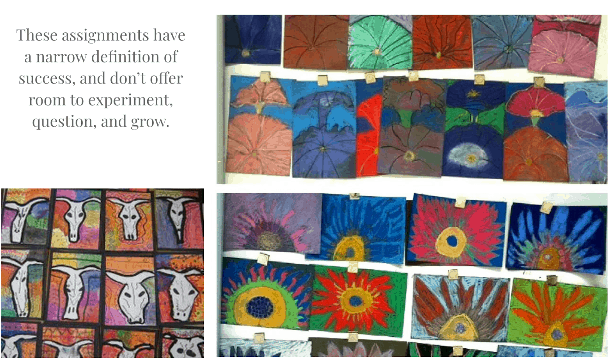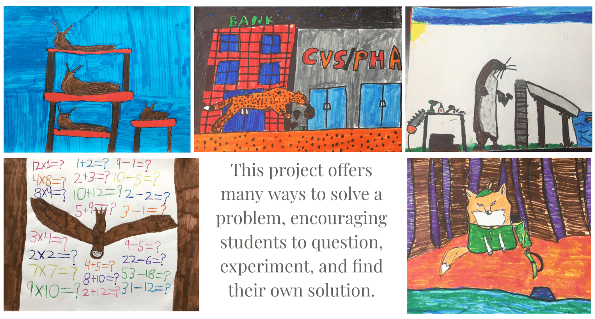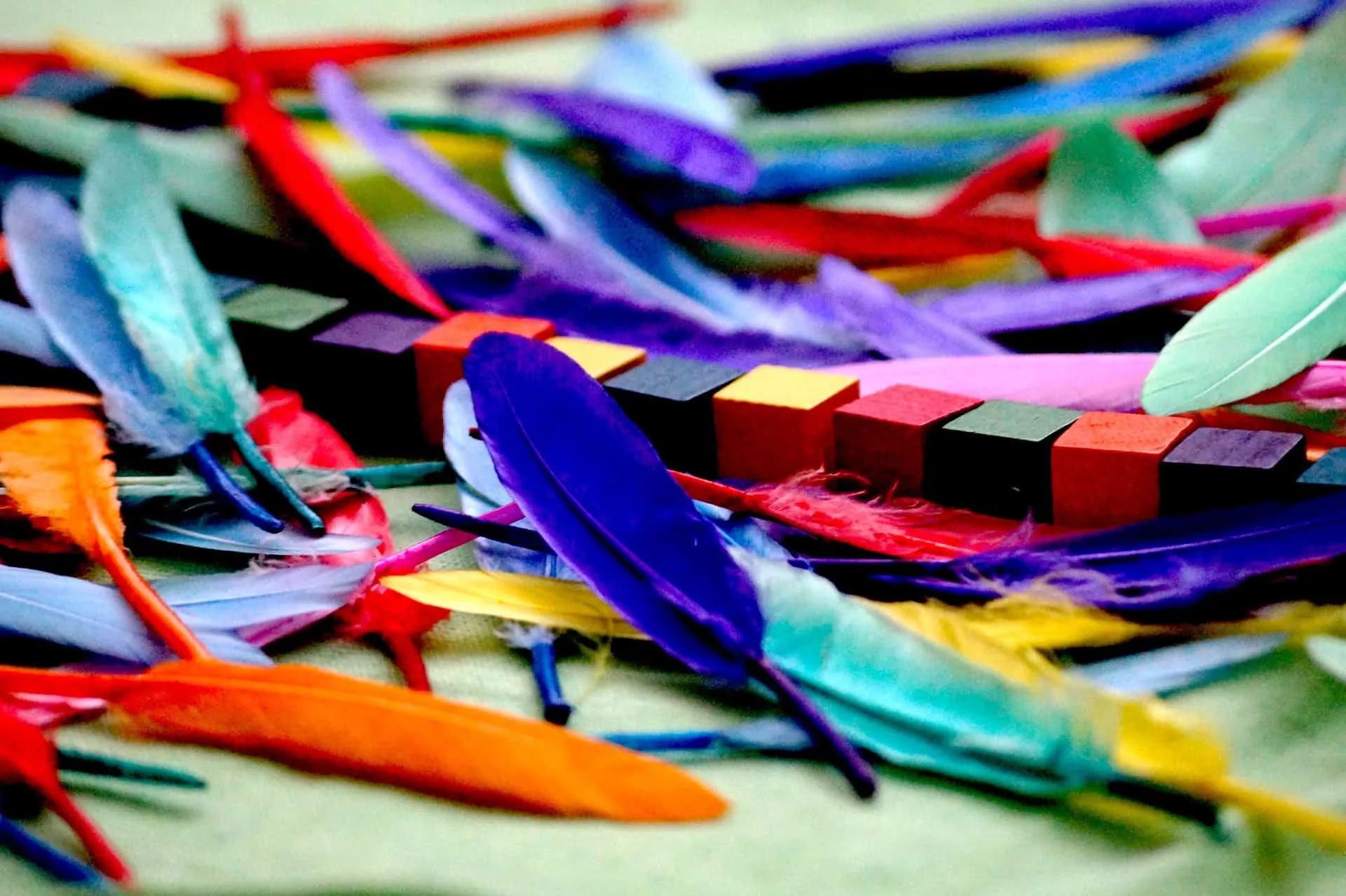Search Pinterest for ‘art lesson,’ and you’ll find many beautiful examples like the ones below. When I taught art at the elementary school, these were the type of projects expected. They provided an easy check-off of objectives and the results were simply assessed. And, frankly, they are pleasing to look at. However, with projects such as these, kids are demonstrating little more than that they can follow directions. It is setting them up to define success in whether or not their picture looks ‘right’ or ‘wrong,’ and offers little opportunity to experiment, question, and grow.
 Images from https://youngartlove.wordpress.com/2013/09/10/the-skulls-of-georgia-okeeffe-5th-grade and http://mshookland.blogspot.com/2016/05/georgia-okeeffe-skulls.html
Images from https://youngartlove.wordpress.com/2013/09/10/the-skulls-of-georgia-okeeffe-5th-grade and http://mshookland.blogspot.com/2016/05/georgia-okeeffe-skulls.html
My background is in studio art, and as a new art teacher, I immediately saw that my students were not engaged with projects such as these. By assigning projects that were effectively ‘follow-the-leader’ prompts, I found I didn’t know anything about their diverse backgrounds, ideas, or personalities, nor was I connecting to what they were learning in a meaningful way. So, I began designing my own projects that would build their knowledge of art content but allow room for students to create their own artwork. The difference was remarkable. Suddenly, ALL the kids were engaged, not just the kids who were already inclined toward art. And this was because they had a safe place to explore their own ideas, tell their own stories, and yes, make and solve their own mistakes. Through these process-focused projects, my students began to recognize that there was more than one way to approach the problem, and that every solution, when well executed, offers a unique perspective. As a result, they learned that, instead of mistakes being a failure to replicate an ideal, they are opportunities to expand ideas and use the process as an opportunity to creatively problem solve.
This assignment marked a sea change in the way that I have since approached teaching art.
I eventually founded an art-education non-profit called Doodles Academy in the hopes of supporting educators with open, high-quality arts lessons that do the same. We create an art curriculum that is easy for any type of educator, with or without a background in the arts, to implement. In doing so, we hope to take some of the burden from teachers, allowing them to focus on lesson implementation rather than design. One of our founding principles is to present projects that get kids excited around an idea or concept, build their knowledge of this content in a way that connects to the goals of Shift 3 required by today’s college- and career-ready standards, but allows them to filter that idea through their own interests and present their own narrative.
All the artworks in the example below are from the same project; students learned about anthropomorphic animals, looking at examples of them through art, literature, and pop culture. They chose an animal, drew it realistically from photographs, and then used the background to show what human traits the animal has come to represent. You can see the radically different ways kids approached the assignment, exploring the concept through their own interests. 5th grade teacher Ms. Howland Bolton said, “The concept of Anthropomorphic Animals is usually a little complex for 5th graders to grasp but they totally got it during this lesson.” By designing our projects with a Growth Mindset in mind, we allow multiple paths for students to engage with the concept. When connected with the learning students are doing in their classroom, it becomes a powerful tool to build knowledge and engagement around core content.
 Image examples from Doodles Academy, an online art curriculum that connects art with classroom content by designing projects around commonly studied topics in literacy, social studies, and science and connecting to big topics and themes from common curricula such as EL Education, CKLA, and Bookworms.
Image examples from Doodles Academy, an online art curriculum that connects art with classroom content by designing projects around commonly studied topics in literacy, social studies, and science and connecting to big topics and themes from common curricula such as EL Education, CKLA, and Bookworms.
‘Growth mindset’ is a term which stems from the incredible research of Stanford psychologist Carol Dweck. Dweck spent two decades researching both adults and children and how they interacted with the world and solved problems. She eventually defined two types of mindsets, ‘fixed’ and ‘growth.’ A “fixed mindset” is one where the person assumes that his or her character, intelligence, and creative ability are static givens which can’t be changed in any meaningful way. A “growth mindset” is one where the person thrives on challenge and sees failure not as evidence of unintelligence but as potential for growth.
I first came across Carol Dweck’s ideas when I was an art teacher at a K-5 school in Brooklyn, and when I began embracing process over product in my classroom, saw powerful results. Ideally, the arts teach kids to be creative, curious, willing to experiment and explore; art instruction teaches them to seek questions, and develop ideas. But, not all art assignments are created equal, and having ‘art time’ is not enough to foster these life skills.
At Doodles Academy, when we train teachers on fostering a growth mindset in the art room, we tell them that they should act as a guide, not an expert. For example:
| Don’t | Instead |
| Mark on a child’s artwork which indicates there is a “right” or a “wrong” approach. | Ask questions to encourage students to examine their own creative approach
OR Encourage classmates to help brainstorm ideas on how to solve the creative problem OR Demonstrate multiple examples on a separate paper |
| Use phrases such as “I like it,” which indicate a non-specific and subjective viewpoint. | Be specific and connect to visual evidence, not opinion.
E.g., Factually describe what you see and neutrally ask the student to elaborate “I notice…” “What can you tell me about that?” |
| Only present answers | Be mindful of presenting and engaging kids in discussion around multiple viewpoints and ways of approaching a problem.
E.g., presenting multiple artworks that address a similar topic, or engaging in whole class discussions to reach a conclusion |
| Present a lot of information at once. | Take your time, and present new skills and concepts in bite-sized chunks that students can thoroughly explore. But continue to challenge kids by scaffolding skills and knowledge over the course of a project. Students feel ‘safe’ experimenting, but because of the conscious skill-building, it is still an intellectually rigorous environment to learn in. |
If we are mindful in the art projects we present to our students, art is ideally set up to foster a growth mindset, which in turn will help our students navigate through their life in a spirit of constant learning.
This post originally appeared on Achieve the Core, in partnership with Student Achievement Partners.


